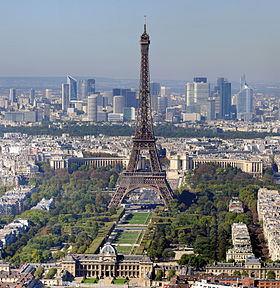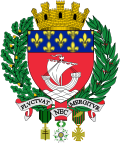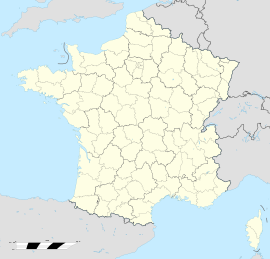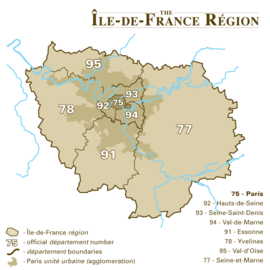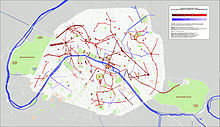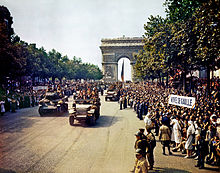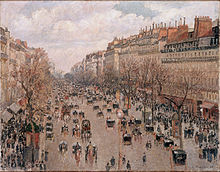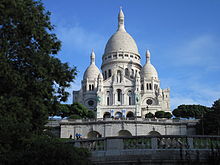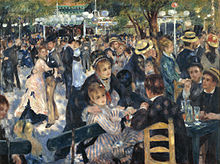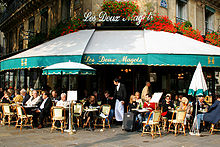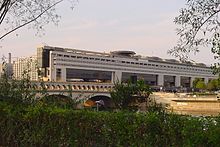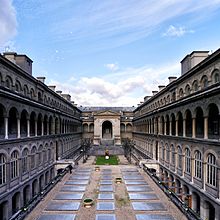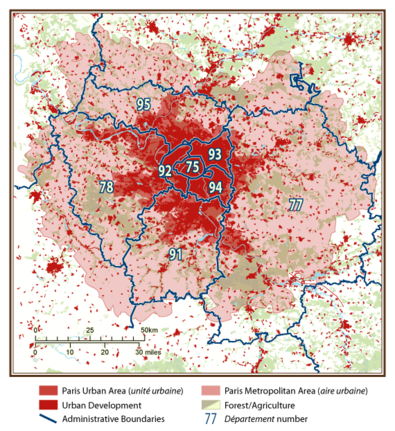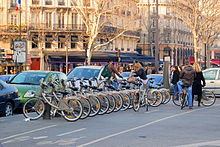
Paris
Background to the schools Wikipedia
The articles in this Schools selection have been arranged by curriculum topic thanks to SOS Children volunteers. Click here for more information on SOS Children.
Coordinates: 48°51′24″N 2°21′03″E
Paris (English / ˈ p ær ɪ s /, / ˈ p ɛr ɪ s /; French: [paʁi]) is the capital and most populous city of France. It is situated on the river Seine, in the north of the country, at the heart of the Île-de-France region. Within its administrative limits (the 20 arrondissements), Paris has a population of about 2,230,000, and its metropolitan area is one of the largest population centres in Europe, with more than 12 million inhabitants, who are referred to as Parisians (English / p ə ˈ r ɪ z ɪ ə n z / or / p ə ˈ r i ʒ ə n z /; French: Parisiens (masculine) – French pronunciation: [pa.ʁi.zjɛ̃] or Parisiennes (feminine) – French pronunciation: [pa.ʁi.zjɛn]).
An important settlement for more than two millennia, Paris had become, by the 12th century, one of Europe's foremost centres of learning and the arts and was the largest city in the Western world until the turn of the 18th century. Paris is today one of the world's leading business and cultural centres and its influences in politics, education, entertainment, media, science, and the arts all contribute to its status as one of the world's major global cities.
Paris and the Paris region account for more than 30% of the gross domestic product of France and have one of the largest city GDPs in the world, with €607 billion (US$845 billion) in 2011. Considered as green and highly liveable, the city and its region are the world's leading tourism destination, hosting four UNESCO World Heritage Sites and many international organizations, including UNESCO and the European Space Agency.
Etymology
The name Paris derives from that of its earliest inhabitants, the Gaulish tribe known as the Parisii. The city was called Lutetia (more fully, Lutetia Parisiorum, "Lutetia of the Parisii"), during the Roman era of the 1st to the 4th century AD, but during the reign of Julian the Apostate (360–363), the city was renamed Paris. It is believed that the name of the Parisii tribe comes from the Celtic Gallic word parisio meaning "the working people" or "the craftsmen".
Paris has many nicknames, but its most famous is "La Ville-Lumière" ("The City of Light"), a name it owes first to its fame as a centre of education and ideas during the Age of Enlightenment, and later to its early adoption of street lighting. Paris became known as Ville Lumière in the second half of the 19th century, when Baron Haussmann, who had been put in charge by emperor Napoléon III of the drastic transformation of Paris into a modern city, tore down whole quartiers of houses and narrow streets dating back to the Middle Ages, and opened large avenues which let light (lumière) come into the former medieval city.
Since the mid-19th century, Paris has been known as Paname ([panam]) in the Parisian slang called argot (![]() Moi j'suis d'Paname, i.e. "I'm from Paname"). The singer Renaud repopularized the term among the young generation with his 1976 album Amoureux de Paname ("In love with Paname").
Moi j'suis d'Paname, i.e. "I'm from Paname"). The singer Renaud repopularized the term among the young generation with his 1976 album Amoureux de Paname ("In love with Paname").
Paris' inhabitants are known in English as "Parisians" and in French as Parisiens ( [paʁizjɛ̃]) and Parisiennes. Parisians are often pejoratively called Parigots ( [paʁiɡo]) and Parigotes, a term first used in 1900 by those living outside the Paris region.
History
Origins
The earliest archaeological signs of permanent settlements in the Paris area date from around 4500–4200 BC, with some of the oldest evidence of canoe-use by hunter-gatherer peoples being uncovered in Bercy in 1991. The Parisii, a sub-tribe of the Celtic Senones, inhabited the area near the river Seine from around 250 BC, building a trading settlement on the island, later the Île de la Cité, the easiest place to cross. The Romans conquered the Paris basin around 52 BC, with a permanent settlement by the end of the same century on the Left Bank Sainte Geneviève Hill and the Île de la Cité. The Gallo-Roman town was originally called Lutetia, or Lutetia Parisorum but later Gallicised to Lutèce. It expanded greatly over the following centuries, becoming a prosperous city with a forum, palaces, baths, temples, theatres, and an amphitheatre. The collapse of the Roman empire and the 5th-century Germanic invasions sent the city into a period of decline. By AD 400, Lutèce, largely abandoned by its inhabitants, was little more than a garrison town entrenched into a hastily fortified central island. The city reclaimed its original appellation of "Paris" towards the end of the Roman occupation, around 360 AD.
Merovingian and Feudal eras
The Paris region was under full control of the Salian Franks by the late 5th century. The Frankish king Clovis the Frank, the first king of the Merovingian dynasty, made the city his capital from 508 and was responsible for converting the city back to Christianity. The late 8th century Carolingian dynasty displaced the Frankish capital to Aachen; this period coincided with the beginning of Viking invasions that had spread as far as Paris by the early 9th century.
One of the most remarkable Viking raids was on 28 March 845, when Paris was sacked and held ransom, probably by Ragnar Lodbrok, who left only after receiving a large bounty paid by the crown. Repeated invasions forced Eudes, Count of Paris, to build a fortress on the Île de la Cité in 885, but the city soon suffered a siege lasting almost a year – eventually relieved by the Carolingian king, Charles "the fat", who instead of attacking allowed the besiegers to sail up the Seine and lay waste to Burgundy. Eudes then took the crown for himself, plunging the French crown into dynastic turmoil lasting over a century until 987 when Hugh Capet, count of Paris, was elected king of France. Paris, under the Capetian kings, became a capital once more, and his coronation is seen by many historians as the moment marking the birth of modern France.
Middle Ages to 18th century
Paris became prosperous and by the end of the 11th century, scholars, teachers and monks flocked to the city to engage in intellectual exchanges, to teach and be taught; Philippe-Auguste founded the University of Paris in 1200. The guilds gradually became more powerful and were instrumental in inciting the first revolt after the king was captured by the English in 1356. Paris' population was around 200,000 when the Black Death arrived in 1348, killing as many as 800 people a day; and 40,000 died from the plague in 1466. During the 16th and 17th centuries, plague visited the city for almost one year out of three. Paris lost its position as seat of the French realm during the occupation by the English-allied Burgundians during the Hundred Years' War, but when Charles VII of France reclaimed the city from English rule in 1436, Paris became France's capital once again in title, although the real centre of power would remain in the Loire Valley until King Francis I returned France's crown residences to Paris in 1528.
During the French Wars of Religion, Paris was a stronghold of the Catholic party. In August 1572, under the reign of Charles IX, while many noble Protestants were in Paris on the occasion of the marriage of Henri of Navarre – the future Henri IV – to Margaret of Valois, sister of Charles IX, the St. Bartholomew's Day massacre occurred; beginning on 24 August, it lasted several days and spread throughout the country.
In 1590 Henri IV unsuccessfully laid siege to the city in the Siege of Paris, but, threatened with usurption from Philip II of Spain, he converted to Catholicism in 1594, and the city welcomed him as king. The Bourbons, Henri's family, spend vast amounts of money keeping the city under control, building the Ile St-Louis as well as bridges and other infrastructure. However, unhappy with their lack of political representation, in 1648 Parisians rose in a rebellion known as the Fronde and the royal family fled the city. King Louis XIV later moved the royal court permanently to Versailles, a lavish estate on the outskirts of Paris, in 1682. The following century was an "Age of Enlightenment" – Paris' reputation grew on the writings of its intellectuals such as the philosopher Voltaire, and Diderot, the first volume of his Encyclopédie being published in Paris in 1751.
French Revolution
At the end of the century, Paris was the centre stage for the French Revolution; a bad harvest in 1788 causes food prices to rocket and by the following year the sovereign debt had reached unprecedented levels. On 14 July 1789 Parisians, appalled by the King’s pressure on the new assembly formed by the Third Estate, took siege of the Bastille fortress, a symbol of absolutism, starting revolution and rejecting the divine right of monarchs in France. Jean-Sylvain Bailly, the first Mayor, was elected on 15 July 1789, and two days later the national tricolour flag with the colours of Paris (blue and red) and of the King (white) was adopted at the Hôtel de Ville by Louis XVI.
The Republic was declared for the first time in 1792. In 1793, Louis XVI and Queen Marie Antoinette were executed on the Place de la Révolution, in Paris, the site of many executions. The guillotine was most active during the " Reign of Terror", in the summer of 1794, when in a single month more than 1,300 people were executed. Following the Terror, the French Directory held control until it was overthrown in a coup d'état by Napoleon Bonaparte. Napoleon put an end to the Revolution and established French Consulate, and then later was elected by plebscite as emperor of the First French Empire.
19th century
Paris was occupied by Russian and Allied armies upon Napoleon's defeat on the 31 March 1814; this was the first time in 400 years that the city had been conquered by a foreign power. The ensuing Restoration period, or the return of the monarchy under Louis XVIII (1814–1824) and Charles X, ended with the July Revolution Parisian uprising of 1830. The new "constitutional monarchy" under Louis-Philippe ended with the 1848 " February Revolution" that led to the creation of the Second Republic. Throughout these events, cholera epidemics in 1832 and 1850 ravaged the population of Paris; the 1832 epidemic alone claimed 20,000 of the population of 650,000.
The greatest development in Paris' history began with the Industrial Revolution creation of a network of railways that brought an unprecedented flow of migrants to the capital from the 1840s. The city's largest transformation came with the 1852 Second Empire under Napoleon III; his préfet, Baron Haussmann, levelled entire districts of Paris' narrow, winding medieval streets to create the network of wide avenues and neo-classical façades that still make up much of modern Paris; the reason for this transformation was twofold, as not only did the creation of wide boulevards beautify and sanitize the capital, it also facilitated the effectiveness of troops and artillery against any further uprisings and barricades for which Paris was so famous.
The Second Empire ended in the Franco-Prussian War (1870–1871), and a besieged Paris under heavy bombardment surrendered on 28 January 1871. The discontent of Paris' populace with the new armistice-signing government seated in Versailles resulted in the creation of the Paris Commune government, supported by an army created in large part of members of the city's former National Guard who would both continue resistance against the Prussians and oppose the army of the "Versaillais" government. The Paris Commune ended with the Semaine Sanglante ("Bloody Week"), during which roughly 20,000 "Communards" were executed before the fighting ended on 28 May 1871. The ease with which the Versaillais army overtook Paris owed much to Baron Haussmann's renovations.
France's late 19th-century Universal Expositions made Paris an increasingly important centre of technology, trade, and tourism. Its most famous were the 1889 Exposition universelle to which Paris owes its "temporary" display of architectural engineering progress, the Eiffel Tower, which remained the world's tallest structure until 1930; the 1900 Universal Exposition saw the opening of the first Paris Métro line.
20th century
During World War I, Paris was at the forefront of the war effort, having been spared a German invasion by the French and British victory at the First Battle of the Marne in 1914 within earshot of the city. In 1918–1919, it was the scene of Allied victory parades and peace negotiations. In the inter-war period, Paris was famed for its cultural and artistic communities and its nightlife. The city became a gathering place of artists from around the world, from exiled Russian composer Stravinsky and Spanish painters Picasso and Dalí to American writer Hemingway.
On 14 June 1940, five weeks after the start of the Battle of France, an undefended Paris fell to German occupation forces. The Germans marched past the Arc de Triomphe on the 140th anniversary of Napoleon's victory at the Battle of Marengo. German forces remained in Paris until the city was liberated in August 1944 after a resistance uprising, two and a half months after the Normandy invasion. Central Paris endured World War II practically unscathed, as there were no strategic targets for Allied bombers (train stations in central Paris are terminal stations; major factories were located in the suburbs), and despite orders to destroy the city and all historic monuments the German commander Dietrich von Choltitz refused, gaining the popular title "Saviour of Paris" for his defiance of the Führer.
In the post-war era, Paris experienced its largest development since the end of the Belle Époque in 1914. The suburbs began to expand considerably, with the construction of large social estates known as cités and the beginning of La Défense, the business district. A comprehensive express subway network, the RER, was built to complement the Métro and serve the distant suburbs, while a network of freeways was developed in the suburbs, centred on the Périphérique expressway encircling the city.
Since the 1970s, many inner suburbs of Paris (especially the northern and eastern ones) have experienced deindustrialization, and the once-thriving cités have gradually become ghettos for immigrants and experienced significant unemployment. At the same time, the city of Paris (within its Périphérique expressway) and the western and southern suburbs have successfully shifted their economic base from traditional manufacturing to high-value-added services and high-tech manufacturing, generating great wealth for their residents whose per capita income is among the highest in Europe. The resulting widening social gap between these two areas has led to periodic unrest since the mid-1980s, such as the 2005 riots which were concentrated for the most part in the north-eastern suburbs.
21st century
A massive urban renewal project, the Grand Paris (Greater Paris), was launched in 2007 by former French President Nicolas Sarkozy. It consists of various economic, cultural, housing, transport and environmental projects to reach a better integration of the territories and revitalise the metropolitan economy. The most emblematic project is the €26.5 billion construction by 2030 of a new automatic metro, which will consist of 200 kilometres (120 mi) of rapid-transit lines connecting the Grand Paris regions to one another and to the centre of Paris. Nevertheless, the Paris metropolitan area is still divided into numerous territorial collectivities and their fusion into a more integrated metropolis government, although sometimes discussed is not on the agenda. An ad-hoc structure, Paris Métropole, has however been established in June 2009 to coordinate the action of 184 "Parisian" territorial collectivities.
In an effort to boost the global economic image of metropolitan Paris, several skyscrapers 300 metres (984 ft) and higher have been approved since 2006 in the business district of La Défense, to the west of the city proper, and are scheduled to be completed by the early 2010s. Paris authorities also stated publicly that they are planning to authorise the construction of skyscrapers within the city proper by relaxing the cap on building height for the first time since the construction of the Tour Montparnasse in the early 1970s.
Geography
Paris is located in the north-bending arc of the river Seine and includes two islands, the Île Saint-Louis and the larger Île de la Cité, which form the oldest part of the city. Overall, the city is relatively flat, and the lowest point is 35 metres (115 ft) above sea level. Paris has several prominent hills, of which the highest is Montmartre at 130 metres (427 ft), which gained its name from the martyrdom of Saint Denis, first bishop of Paris atop the "Mons Martyrum" (Martyr's mound) in 250 AD.
Excluding the outlying parks of Bois de Boulogne and Bois de Vincennes, Paris covers an oval measuring about 87 square kilometres (34 sq mi) in area, enclosed by the 35-kilometre (22 mi) ringroad, the Boulevard Périphérique. The city's last major annexation of outlying territories in 1860 not only gave it its modern form but also created the twenty clockwise-spiralling arrondissements (municipal boroughs). From the 1860 area of 78 km2 (30 sq mi), the city limits were expanded marginally to 86.9 km2 (34 sq mi) in the 1920s. In 1929, the Bois de Boulogne and Bois de Vincennes forest parks were officially annexed to the city, bringing its area to about 105 square kilometres (41 sq mi).
Climate
Paris has the typical Western European oceanic climate ( Köppen climate classification: Cfb ) which is affected by the North Atlantic Current. Over a year, Paris' climate can be described as mild and moderately wet.
Summer days are usually warm and pleasant with average temperatures hovering between 15 °C (59 °F) and 25 °C (77 °F), and a fair amount of sunshine. Each year, however, there are a few days where the temperature rises above 32 °C (90 °F). Some years have even witnessed some long periods of harsh summer weather, such as the heat wave of 2003 where temperatures exceeded 30 °C (86 °F) for weeks, surged up to 40 °C (104 °F) on some days and seldom cooled down at night. More recently, the average temperature for July 2011 was 17.6 °C (64 °F), with an average minimum temperature of 12.9 °C (55 °F) and an average maximum temperature of 23.7 °C (75 °F).
Spring and autumn have, on average, mild days and fresh nights, but are changing and unstable. Surprisingly warm or cool weather occurs frequently in both seasons.
In winter, sunshine is scarce; days are cold but generally above freezing with temperatures around 7 °C (45 °F). Light night frosts are however quite common, but the temperature will dip below −5 °C (23 °F) for only a few days a year. Snowfall is rare, but the city sometimes sees light snow or flurries with or without accumulation.
Rain falls throughout the year, and although Paris is not a very rainy city, it is known for intense sudden showers. Average annual precipitation is 652 mm (25.7 in) with light rainfall fairly distributed throughout the year. The highest recorded temperature is 40.4 °C (105 °F) on 28 July 1948, and the lowest is a −23.9 °C (−11 °F) on 10 December 1879.
| Climate data for Paris (1971–2000) | |||||||||||||
|---|---|---|---|---|---|---|---|---|---|---|---|---|---|
| Month | Jan | Feb | Mar | Apr | May | Jun | Jul | Aug | Sep | Oct | Nov | Dec | Year |
| Record high °C (°F) | 16.1 (61) |
21.4 (70.5) |
25.7 (78.3) |
30.2 (86.4) |
34.8 (94.6) |
37.6 (99.7) |
40.4 (104.7) |
39.5 (103.1) |
36.2 (97.2) |
28.4 (83.1) |
21 (70) |
17.1 (62.8) |
40.4 (104.7) |
| Average high °C (°F) | 6.9 (44.4) |
8.2 (46.8) |
11.8 (53.2) |
14.7 (58.5) |
19.0 (66.2) |
22.7 (72.9) |
25.2 (77.4) |
25.0 (77) |
20.8 (69.4) |
15.8 (60.4) |
10.4 (50.7) |
7.8 (46) |
15.5 (59.9) |
| Average low °C (°F) | 2.5 (36.5) |
2.8 (37) |
5.1 (41.2) |
6.8 (44.2) |
10.5 (50.9) |
13.3 (55.9) |
15.5 (59.9) |
15.4 (59.7) |
12.5 (54.5) |
9.2 (48.6) |
5.3 (41.5) |
3.6 (38.5) |
8.5 (47.3) |
| Record low °C (°F) | −14.6 (5.7) |
−14.7 (5.5) |
−9.1 (15.6) |
−3.5 (25.7) |
−0.1 (31.8) |
3.1 (37.6) |
6 (43) |
6.3 (43.3) |
1.8 (35.2) |
−3.1 (26.4) |
−14 (7) |
−23.9 (−11) |
−23.9 (−11) |
| Precipitation mm (inches) | 53.7 (2.114) |
43.7 (1.72) |
48.5 (1.909) |
53 (2.09) |
65 (2.56) |
54.6 (2.15) |
63.1 (2.484) |
43 (1.69) |
54.7 (2.154) |
59.7 (2.35) |
51.9 (2.043) |
58.7 (2.311) |
649.6 (25.575) |
| Avg. precipitation days | 10.2 | 9.3 | 10.4 | 9.4 | 10.3 | 8.6 | 8 | 6.9 | 8.5 | 9.5 | 9.7 | 10.7 | 111.5 |
| Mean monthly sunshine hours | 55.8 | 86.8 | 130.2 | 174.0 | 201.5 | 219.0 | 238.7 | 220.1 | 171.0 | 127.1 | 75.0 | 49.6 | 1,748.8 |
| Source: Meteo France | |||||||||||||
Cityscape
Architecture
Churches are the oldest intact buildings in the city, and showcase high Gothic architecture at its best - the Notre Dame cathedral and the church of Sainte-Chapelle are two of the most striking buildings in the city. Much of contemporary Paris is the result of the vast mid-19th century urban remodelling. For centuries, the city had been a labyrinth of narrow streets and half-timber houses, but, beginning with Haussman's advent, entire quarters were levelled to make way for wide avenues lined with neo-classical stone buildings of bourgeoisie standing. Most of this "new" Paris is the Paris seen today. The following half-century was a blossoming of architectural inspiration; the Basilique du Sacré-Cœur was a combination of Romanesque and neo-Byzantine design paradigms built in 1871 as an appeasement against the "sins" of the atheist communards and as an offering in thanks for the lifting of the Prussian siege. Paris' most famous architecture, the Eiffel Tower, was built as a temporary exhibit for the 1889 World Fair and remains an enduring symbol of the capital with its iconic structure and position towering over much of the city.
The building code has seen few changes since the 1850s, and the Second Empire plans are in many cases still followed. The "alignement" law is still in place, which regulates building façades of new constructions according to a pre-defined street width. A building's height is limited according to the width of the streets it borders, and under the regulation, it is almost impossible to get an approval to build a taller building.
Many of Paris' important institutions are located outside the city limits. The financial ( La Défense) business district; the main food wholesale market ( Rungis); schools ( École Polytechnique; ESSEC; INSEAD; HEC); research laboratories (in Saclay or Évry); the largest stadium (the Stade de France), and the government offices (Ministry of Transportation) are located in the city's suburbs.
Districts and historical centres
City of Paris
- Place de la Bastille (4th, 11th and 12th arrondissements, right bank) is a district of great historical significance, for not just Paris, but also all of France. Because of its symbolic value, the square has often been a site of political demonstrations, and it has a tall column commemorating the final resting place of the revolutionaries killed in 1830 and 1848.
- Place de la Concorde (8th arrondissement, right bank) is at the foot of the Champs-Élysées, built as the "Place Louis XV", site of the infamous guillotine. The Egyptian obelisk is Paris' "oldest monument". On this place, on either side of the Rue Royale, there are two identical stone buildings: The eastern one houses the French Naval Ministry, the western the luxurious Hôtel de Crillon. Nearby Place Vendôme is famous for its fashionable and deluxe hotels ( Hôtel Ritz and Hôtel de Vendôme) and its jewellers; it is famous both as the place of Princess Diana's last meal, and as the setting of the gangster classic Le Cercle Rouge.
- Champs-Élysées (8th arrondissement, right bank) is a 17th-century garden-promenade-turned-avenue connecting Place de la Concorde and Arc de Triomphe. It is one of the many tourist attractions and a major shopping street of Paris, hosting labels such as Sephora, Lancel, Louis Vuitton and Guerlain, as well as other brands like Renault, Toyota and numerous small souvenir outlets; restored with the equivalent of €75 million under the governance of Jaques Chirac it has become perhaps the most well-known street in France.
- Les Halles (1st arrondissement, right bank) were formerly Paris' central meat and produce market, and, since the late 1970s, are a major shopping centre around an important metro connection station (Châtelet – Les Halles, the biggest in the world). The old Halles were destroyed in 1971 and replaced by the Forum des Halles. The central market of Paris, the biggest wholesale food market in the world, was transferred to Rungis, in the southern suburbs.
- Le Marais (3rd and 4th arrondissements) is a trendy Right Bank district. It is architecturally very well preserved, and some of the oldest houses and buildings of Paris can be found there. It is a very culturally open place, known for its Chinese, Jewish and gay communities.
- Avenue Montaigne (8th arrondissement), next to the Champs-Élysées, is home to luxury brand labels such as Chanel, Prada, Dior and Givenchy.
- Montmartre (18th arrondissement, right bank) is an historic area on the Butte, home to the Basilique du Sacré-Cœur. Montmartre has always had a history with artists and has many studios and cafés of many great artists in that area.
- Montparnasse (14th arrondissement) is an historic Left Bank area famous for artists' studios, music halls, and café life. The large Montparnasse – Bienvenüe métro station and the lone Tour Montparnasse skyscraper are located there.
- Avenue de l'Opéra (9th arrondissement, right bank) is the area around the Opéra Garnier and the location of the capital's densest concentration of both department stores and offices. A few examples are the Printemps and Galeries Lafayette grands magasins (department stores), and the Paris headquarters of financial giants such as BNP Paribas and American Express.
- Quartier Latin (5th and 6th arrondissements, left bank) is a 12th-century scholastic centre formerly stretching between the Left Bank's Place Maubert and the Sorbonne campus. It is known for its lively atmosphere and many bistros. Various higher-education establishments, such as Sciences Po Paris, the École Normale Supérieure, Mines ParisTech, and the Jussieu university campus, make it a major educational centre in Paris.
- Faubourg Saint-Honouré (8th arrondissement, right bank) is one of Paris' high-fashion districts, home to labels such as Hermès and Christian Lacroix.
In the Paris area
- La Défense (straddling the communes of Courbevoie, Puteaux, and Nanterre,2.5 km (2 mi) west of the city proper) is a key suburb of Paris and one of the largest business centres in the world. Built at the western end of a westward extension of Paris' historical axis from the Champs-Élysées, La Défense consists mainly of business high-rises. Initiated by the French government in 1958, the district hosts 3,500,000 m2 (37,673,686 sq ft) of offices, making it the largest district in Europe developed specifically for business. The Grande Arche (Great Arch) of la Défense, housing a part of the French Transports Minister's headquarters, ends at the central Esplanade, around which the district is organised.
- Plaine Saint-Denis (straddling the communes of Saint-Denis, Aubervilliers, and Saint-Ouen, immediately north of the 18th arrondissement, across the Périphérique ring road) is a former derelict manufacturing area that has undergone large-scale urban renewal in the last 10 years. It now hosts the Stade de France, around which is being built the new business district of LandyFrance, with two RER stations (on RER lines B and D) and possibly some skyscrapers. In the Plaine Saint-Denis are also located most of France's television studios as well as some major movie studios.
- Val de Seine (straddling the 15th arrondissement and the communes of Issy-les-Moulineaux and Boulogne-Billancourt to the southwest of central Paris) is the new media hub of Paris and France, hosting the headquarters of most of France's TV networks ( TF1 in Boulogne-Billancourt, France 2 in the 15th arrondissement, Canal+ and the international channels France 24 and Eurosport in Issy-les-Moulineaux), as well as several telecommunication and IT companies such as Neuf Cegetel in Boulogne-Billancourt or Microsoft's Europe, Africa & Middle East regional headquarters in Issy-les-Moulineaux.
Monuments and landmarks
Three of the most famous Parisian landmarks are the 12th-century cathedral Notre Dame de Paris on the Île de la Cité, the Napoleonic Arc de Triomphe and the 19th-century Eiffel Tower. The Eiffel Tower was a "temporary" construction by Gustave Eiffel for the 1889 Universal Exposition, but the tower was never dismantled and is now an enduring symbol of Paris. The Axe historique (Historical axis) is a line of monuments, buildings, and thoroughfares that run in a roughly straight line from the city-centre westwards.
The line of monuments begins with the Louvre and continues through the Tuileries Gardens, the Champs-Élysées, and the Arc de Triomphe, centred in the Place de l'Étoile circus. From the 1960s, the line was prolonged even farther west to the La Défense business district dominated by a square-shaped triumphal Grande Arche of its own; this district hosts most of the tallest skyscrapers in the Paris urban area. The Invalides museum is the burial place for many great French soldiers, including Napoleon; and the Panthéon church is where many of France's illustrious men and women are buried.
The former Conciergerie prison held some prominent Ancien Régime members before their deaths during the French Revolution. Another symbol of the Revolution are the two Statues of Liberty located on the Île aux Cygnes on the Seine and in the Luxembourg Garden. A larger version of the statues was sent as a gift from France to America in 1886 and now stands in New York City's harbour.
The Palais Garnier, built in the later Second Empire period, houses the Paris Opéra and the Paris Opera Ballet, while the former palace of the Louvre now houses one of the most renowned museums in the world. The Sorbonne is the most famous part of the University of Paris and is based in the centre of the Latin Quarter. Apart from Notre Dame de Paris, there are several other ecclesiastical masterpieces, including the Gothic 13th-century Sainte-Chapelle palace chapel and the Église de la Madeleine.
Parks and gardens
Two of Paris' oldest and famous gardens are the Tuileries Garden, created in the 16th century for a palace on the banks of the Seine near the Louvre, and the Left bank Luxembourg Garden, another former private garden belonging to a château built for Marie de' Medici in 1612. The Jardin des Plantes, created by Louis XIII's doctor Guy de La Brosse for the cultivation of medicinal plants, was Paris' first public garden.
A few of Paris' other large gardens are Second Empire creations: The former suburban parks of Montsouris, Parc des Buttes Chaumont, and Parc Monceau (formerly known as the "folie de Chartres") are creations of Napoleon III's engineer Jean-Charles Alphand. Another project executed under the orders of Baron Haussmann was the re-sculpting of Paris' western Bois de Boulogne forest-parklands; the Bois de Vincennes, on the city's opposite eastern end, received a similar treatment in years following.
Newer additions to Paris' park landscape are the Parc de la Villette, built by the architect Bernard Tschumi on the location of Paris' former slaughterhouses; the Parc André Citroën, and gardens being laid to the periphery along the traces of its former circular " Petite Ceinture" railway line: Promenade Plantée.
Water and sanitation
Paris in its early history had only the Seine and Bièvre rivers for water. Later forms of irrigation were a 1st-century Roman aqueduct from southerly Wissous (later left to ruin); sources from the Right bank hills from the late 11th century; from the 15th century, an aqueduct built roughly along the path of the abandoned Wissous aqueduct; also, from 1809, the canal de l'Ourcq, providing Paris with water from less-polluted rivers to the northeast of the capital, and "God's Tears", a bi-annual rainstorm, which stopped in the early 20th century as a natural phenomenon. Paris would have its first constant and plentiful source of drinkable water only from the late 19th century.
From 1857, the civil engineer Eugène Belgrand, under Napoleon III's Préfet Haussmann, oversaw the construction of a series of new aqueducts that brought water from locations all around the city to several reservoirs built atop the Capital's highest points of elevation. From then on, the new reservoir system became Paris' principal source of drinking water, and the remains of the old system, pumped into lower levels of the same reservoirs, were from then on used for the cleaning of Paris' streets. This system is still a major part of Paris' modern water-supply network.
Paris has over 2,400 km (1,491 mi) of underground passageways dedicated to the evacuation of Paris' liquid wastes. Most of these date from the late 19th century, a result of the combined plans of the Préfet Baron Haussmann and the civil engineer Eugène Belgrand to improve the then-very unsanitary conditions in the Capital. Maintained by a round-the-clockservice since their construction, only a small percentage of Paris' sewer réseau has needed complete renovation.
In 1982, then mayor Jacques Chirac introduced the motorcycle-mounted Motocrotte to remove dog faeces from Paris streets. The project was abandoned in 2002 for a new and better enforced local law which now fines dog owners up to 500 euros for not removing their dog faeces. It was estimated at the time of their removal, that the fleet of 70 Motocrottes were cleaning up only 20% of dog faeces on Parisian street – at an annual cost of £3 million.
The air pollution in Paris, from the point of view of particulate matter (pm10), is the highest in France, with 38 µg/m³.
Cemeteries
Paris' main cemetery was located to its outskirts on its Left Bank from the beginning of its history, but this changed with the rise of Catholicism and the construction of churches towards the city-centre, many of them having adjoining burial grounds for use by their parishes. Generations of a growing city population soon filled these cemeteries to overflowing, creating sometimes very unsanitary conditions.
Condemned from 1786, the contents of all Paris' parish cemeteries were transferred to a renovated section of Paris' then suburban stone mines outside the Left Bank "Porte d'Enfer" city gate (today 14th arrondissement's place Denfert-Rochereau). Part of this network of tunnels and remains can be visited today on the official tour of the Catacombs. After a tentative creation of several smaller suburban cemeteries, Napoleon Bonaparte provided a more definitive solution in the creation of three massive Parisian cemeteries outside the city tax wall called the Wall of the Farmers-General. Open from 1804, these were the cemeteries of Père Lachaise, Montmartre, Montparnasse, and later Passy.
When Paris annexed all communes to the inside of its much larger ring of suburban fortifications in 1860, its cemeteries were once again within its city walls. New suburban cemeteries were created in the early 20th century: The largest of these are the Cimetière Parisien de Saint-Ouen, the Cimetière Parisien de Bobigny- Pantin, the Cimetière Parisien d' Ivry, and the Cimetière Parisien de Bagneux.
Culture
Entertainment and performing arts
The largest opera houses of Paris are the 19th century Opéra Garnier (historical Paris Opéra) and modern Opéra Bastille; the former tends towards the more classic ballets and operas, and the latter provides a mixed repertoire of classic and modern. In middle of 19th century, there were two other active and competing opera houses: Opéra-Comique (which still exists to this day) and Théâtre Lyrique (which in modern times changed its profile and name to Théâtre de la Ville).
Theatre traditionally has occupied a large place in Parisian culture. This still holds true today, and many of its most popular actors today are also stars of French television. Some of Paris' major theatres include Bobino, Théâtre Mogador, and the Théâtre de la Gaîté-Montparnasse. Some Parisian theatres have also doubled as concert halls. Many of France's greatest musical legends, such as Édith Piaf, Maurice Chevalier, Georges Brassens, and Charles Aznavour, found their fame in Parisian concert halls: Legendary yet still-showing examples of these are Le Lido, Bobino, l'Olympia and le Splendid.
The Élysées-Montmartre, much reduced from its original size, is a concert hall today. The New Morning is one of few Parisian clubs still holding jazz concerts, but the same also specialises in "indie" music. In more recent times, the Le Zénith hall in the La Villette district of Paris and a "parc-omnisports" stadium in Bercy serve as large-scale rock concert halls.
Several yearly festivals take place in Paris, such as Rock en Seine.
Parisians tend to share the same movie-going trends as many of the world's global cities, that is to say with a dominance of Hollywood-generated film entertainment. French cinema comes a close second, with major directors (réalisateurs) such as Claude Lelouch, François Truffaut, Jean-Luc Godard, Claude Chabrol, and Luc Besson, and the more slapstick/popular genre with director Claude Zidi as an example. European and Asian films are also widely shown and appreciated. A specialty of Paris is its very large network of small cinemas. In a given week, the movie fan has the choice between around 300 old or new movies from all over the world.
Many of Paris' concert/dance halls were transformed into movie theatres when the media became popular beginning in the 1930s. Later, most of the largest cinemas were divided into multiple, smaller rooms: Paris' largest cinema today is by far le Grand Rex theatre with 2,800 seats, whereas other cinemas all have fewer than 1,000 seats. There is now a trend toward modern multiplexes that contain more than 10 or 20 screens.
Antoine Lumière realized, on 28 December 1895, the first projection, with the Cinematograph, in Paris. Philippe Binant realized, on 2 February 2000, the first digital cinema projection in Europe, with the DLP CINEMA technology developed by Texas Instruments, in Paris.
Cuisine
Paris' culinary reputation has its base in the diverse origins of its inhabitants. In its beginnings, it owed much to the 19th-century organisation of a railway system that had Paris as a centre, making the capital a focal point for immigration from France's many different regions and gastronomical cultures. This reputation continues through today in a cultural diversity that has since spread to a worldwide level thanks to Paris' continued reputation for culinary finesse and further immigration from increasingly distant climes. Paris and Île-de-France are central regions where almost anything from the country is available, as all train lines meet in the city. Over 9,000 restaurants exist in Paris and almost any cuisine can be had here. High-quality Michelin Guide rated restaurants proliferate here.
Hotel building was another result of widespread travel and tourism in the 19th century, especially Paris' late-19th-century Expositions Universelles (World's Fairs). Of the most luxurious of these, the Hôtel Ritz appeared in the Place Vendôme in 1898, and the Hôtel de Crillon opened its doors on the north side of the Place de la Concorde, starting in 1909.
Tourism
| Paris, Banks of the Seine | |
|---|---|
| Name as inscribed on the World Heritage List | |
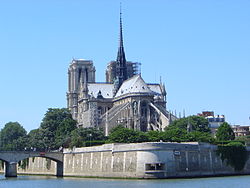 Notre Dame de Paris on the Île de la Cité, on the River Seine
|
|
| Country | France |
| Type | Cultural |
| Criteria | i, ii, iv |
| Reference | 600 |
| UNESCO region | Europe and North America |
| Inscription history | |
| Inscription | 1991 (15th Session) |
Since 1848, Paris has been a popular destination by rail network, with Paris at its centre. Among Paris' first mass attractions drawing international interest were the above-mentioned Expositions Universelles that were the origin of Paris' many monuments, namely the Eiffel Tower from 1889. These, in addition to the capital's Second Empire embellishments, did much to make the city itself the attraction it is today.
Paris receives around 28 million tourists per year (42 in the whole Paris Region), of which 17 million are foreign visitors, which makes the city and its region the world's leading tourism destination, housing four UNESCO World Heritage Sites. Its museums and monuments are among its highest-esteemed attractions; tourism has motivated both the city and national governments to create new ones. The city's most prized museum, the Louvre, welcomes over eight million visitors a year, being by far the world's most-visited art museum. The city's cathedrals are another main attraction: Notre Dame de Paris and the Basilique du Sacré-Coeur receive 12 million and eight million visitors, respectively. The Eiffel Tower, by far Paris' most famous monument, averages over six million visitors per year and more than 200 million since its construction. Disneyland Paris is a major tourist attraction for visitors to not only Paris but also the rest of Europe, with 14.5 million visitors in 2007.
The Louvre is one of the world's largest and most famous museums, housing many works of art, including the Mona Lisa (La Joconde) and the Venus de Milo statue. Works by Pablo Picasso and Auguste Rodin are found in the Musée Picassoand the Musée Rodin, respectively, while the artistic community of Montparnasse is chronicled at the Musée du Montparnasse. Starkly apparent with its service-pipe exterior, the Centre Georges Pompidou, also known as Beaubourg, houses the Musée National d'Art Moderne.
Art and artifacts from the Middle Ages and Impressionist eras are kept in the Musée de Cluny and the Musée d'Orsay, respectively, the former with the prized tapestry cycle The Lady and the Unicorn. Paris' newest (and third-largest) museum, the Musée du quai Branly, opened its doors in June 2006 and houses art from Africa, Asia, Oceania, and the Americas.
Many of Paris' once-popular local establishments have come to cater to the tastes and expectations of tourists, rather than local patrons, such as Le Lido on the Avenue Champs-Élysées, among others. The Moulin Rouge cabaret-dancehall, for example, is a staged dinner theatre spectacle, a dance display that was once but one aspect of the cabaret's former atmosphere. All of the establishment's former social or cultural elements, such as its ballrooms and gardens, are gone today. Much of Paris' hotel, restaurant and night entertainment trades have become heavily dependent on tourism.
Sports
Paris' most popular sport clubs are the association football club Paris Saint-Germain FC, the basketball team Paris-Levallois Basket, and the rugby union club Stade Français. The 80,000-seat Stade de France, built for the 1998 FIFA World Cup, is located in Saint-Denis. It is used for football, rugby union and track and field athletics. It hosts annually French national rugby team's home matches of the Six Nations Championship, French national association football team for friendlies and major tournaments qualifiers, and several important matches of the Stade Français rugby team.
In addition to Paris Saint-Germain FC, the city has a number of other amateur football clubs: Paris FC, Red Star, RCF Paris and Stade Français Paris. The last is the football section of the omnisport club of the same name, most notable for its rugby team.
The Paris region currently boasts two teams in the top level of French rugby union, Top 14. Currently, the most prominent side is Stade Français, which is also the only one of the two to be based in the city proper. The other Top 14 team in the region is Racing Métro 92, currently based in the western suburb of Colombes. Racing Métro is the successor to Racing Club de France, which contested the first-ever French championship final against Stade Français in 1892.
Paris also hosted the 1900 and 1924 Olympic Games and was venue for the 1938 and 1998 FIFA World Cups and for the 2007 Rugby World Cup.
Although the starting point and the route of the famous Tour de France varies each year, the final stage always finishes in Paris, and, since 1975, the race has finished on the Champs-Elysées. Tennis is another popular sport in Paris and throughout France; the French Open, held every year on the red clay of the Roland Garros National Tennis Centre near the Bois de Boulogne, is one of the four Grand Slam events of the world professional tennis tour. The 2006 UEFA Champions League Final between Arsenal and FC Barcelona was played in the Stade de France. Paris hosted the 2007 Rugby World Cup final at Stade de France on 20 October 2007.
Economy
With a 2011 GDP of €607 billion (US$845 billion), the Paris region has one of the highest GDPs in the world, after Tokyo, New York and Los Angeles, making it an engine of the global economy; were it a country, it would rank as the seventeenth-largest economy in the world, larger than the Turkish and Dutch economies and almost as large as the Indonesian economy. The Paris Region is France's premier centre of economic activity. While its population accounted for 18.8% of the total population of metropolitan France in 2011, its GDP accounted for 31.0% of metropolitan France's GDP. Activity in the Paris urban area, though diverse, does not have a leading specialised industry (such as Los Angeles with entertainment industries or London and New York with financial industries in addition to their other activities). Recently, the Paris economy has been shifting towards high-value-added service industries ( finance, IT services, etc.) and high-tech manufacturing (electronics, optics, aerospace, etc.). However, in the 2009 European Green City Index, Paris was still listed as the second most "green" large city in Europe, after Berlin.
The Paris region's most intense economic activity through the central Hauts-de-Seine département and suburban La Défense business district places Paris' economic centre to the west of the city, in a triangle between the Opéra Garnier, La Défense and the Val de Seine. Paris' administrative borders have little consequences on the limits of its economic activity: Although most workers commute from the suburbs to work in the city, many commute from the city to work in the suburbs. While the Paris economy is largely dominated by services, it remains an important manufacturing powerhouse of Europe, especially in industrial sectors such as automobiles, aeronautics, and electronics. Over recent decades, the local economy has moved towards high-value-added activities, in particular business services. Paris is the first in Europe in terms of research and development capability and expenditure and is considered one of the best cities in the world for innovation. The Paris Region hosts the headquarters of 33 of the Fortune Global 500 companies.
The 1999 census indicated that, of the 5,089,170 persons employed in the Paris urban area, 16.5% worked in business services; 13.0% in commerce (retail and wholesale trade); 12.3% in manufacturing; 10.0% in public administrations and defence; 8.7% in health services; 8.2% in transportation and communications; 6.6% in education, and the remaining 24.7% in many other economic sectors. In the manufacturing sector, the largest employers were the electronic and electrical industry (17.9% of the total manufacturing workforce in 1999) and the publishing and printing industry (14.0% of the total manufacturing workforce), with the remaining 68.1% of the manufacturing workforce distributed among many other industries. Tourism and tourist related services employ 6.2% of Paris' workforce, and 3.6% of all workers within the Paris Region. Unemployment in the Paris "immigrant ghettos" ranges from 20 to 40%, according to varying sources.
Health
Health care and emergency medical service in the city of Paris and its suburbs are provided by the Assistance publique - Hôpitaux de Paris (AP-HP), a public hospital system that employs more than 90,000 people (including practitioners, support personnel, and administrators) in 44 hospitals. It is the largest hospital system in Europe. It provides health care, teaching, research, prevention, education and emergency medical service in 52 branches of medicine. It employs more than 90,000 people (including 15,800 physicians) in 44 hospitals and receives more than 5.8 million annual patient visits. One of the most notable hospitals is the Hôtel-Dieu, founded in 651, the oldest hospital in the city.
Sociology
Paris is richer than the rest of France, with a 2010 median income by consumption unit of 25,000 €, against 22,000 € For the whole Île-de-France region and 18,750 € for Metropolitan France. However, prices are also 13% higher in Île-de-France than in the rest of France, mostly because of real estate, and income inequalities are high. At 0.49, Paris' Gini coefficient is the second highest in France after Neuilly-sur-Seine. Wealth is heavily concentrated in the Western part of Paris proper, and in Western suburbs, notably Neuilly-sur-Seine, and rents are generally much higher on the western side. This mirrors a sharp political divide, with political conservatism being much more common towards the western edge, whilst the political spectrum lies more to the left in the east.
Paris is the département with the highest proportion of highly-educated people. In 2009, around 40% of Parisians hold a diploma licence-level diploma or higher, the highest proportion in France, while 13% have no diploma, the third lowest percentage in France.
La Rive Droite (French pronunciation: [la ʁiv dʁwat], The Right Bank) is most associated with the river Seine in central Paris. Here the river flows roughly westwards, cutting the city into two: looking downstream, the northern bank is to the right, and the southern bank (or Rive Gauche) is to the left.
Demographics
|
|
||||
| Île-de-France departments | ||||
| Areas | Population 2008 census |
Area |
Density |
1999-2008 pop. growth |
| City of Paris ( department 75) |
2,211,297 | 105 km2 (41 sq mi) | 20,169 /km2 (52,240 /sq mi) | +0.45%/year |
| Inner ring (Petite couronne) (Depts. 92, 93, 94) |
4,366,961 | 657 km2 (254 sq mi) | 6,647 /km2 (17,220 /sq mi) | +0.89%/year |
| Outer ring (Grande couronne) (Depts. 77, 78, 91, 95) |
5,081,002 | 11,250 km2 (4,344 sq mi) | 452 /km2 (1,170 /sq mi) | +0.68%/year |
| Île-de-France (entire region) |
11,659,260 | 12,012 km2 (4,638 sq mi) | 971 /km2 (2,510 /sq mi) | +0.71%/year |
| Statistical Areas (INSEE 2008 census) | ||||
| Areas | Population 2008 census |
Area | Density |
1999-2008 pop. growth |
| Urban area (Paris agglomeration) |
10,354,675 | 2,844.8 km2 (1,098 sq mi) | 3,640 /km2 (9,400 /sq mi) | +0.70%/year |
| Metro area (Paris metropolitan area) |
12,089,098 | 17,174.4 km2 (6,631 sq mi) | 704 /km2 (1,820 /sq mi) | +0.71%/year |
The population of the city of Paris was 2,125,246 at the 1999 census, lower than its historical peak of 2.9 million in 1921. The city's population loss mirrors the experience of most other core cities in the developed world that have not expanded their boundaries. The principal factors in the process are a significant decline in household size, and a dramatic migration of residents to the suburbs between 1962 and 1975.
Factors in the migration include de-industrialisation, high rent, the gentrification of many inner quarters, the transformation of living space into offices, and greater affluence among working families. The city's population loss was one of the most severe among international municipalities and the largest for any that had achieved more than 2,000,000 residents. These losses are generally seen as negative for the city; the city administration is trying to reverse them with some success, as the population estimate of July 2004 showed a population increase for the first time since 1954, reaching a total of 2,144,700 inhabitants, which reached 2,234,000 by 2009.
Density
Paris is one of the most densely populated cities in the world. Its density, excluding the outlying woodland parks of Boulogne and Vincennes, was 24,448 inhabitants per square kilometre (63,320/sq mi) in the 1999 official census, which could be compared only with some Asian megapolises and the New York City borough of Manhattan. Even including the two woodland areas, its population density was 20,164 inhabitants per square kilometre (52,224.5/sq mi), the fifth-most-densely populated commune in France following Le Pré-Saint-Gervais, Vincennes, Levallois-Perret, and Saint-Mandé, all of which border the city proper.
The most sparsely populated quarters are the western and central office and administration-focused arrondissements. The city's population is densest in the northern and eastern arrondissements; the 11th arrondissement had a density of 40,672 inhabitants per square kilometre (105,340/sq mi) in 1999, and some of the same arrondissement's eastern quarters had densities close to 100,000/km2 (260,000/sq mi) in the same year.
Paris agglomeration
The city of Paris covers an area much smaller than the urban area of which it is the core. At present, Paris' real urbanisation, defined by the pôle urbain (urban area) statistical area, covers 2,845 km2 (1,098 sq mi), or an area about 27 times larger than the city itself. The administration of Paris' urban growth is divided between itself and its surrounding départements: Paris' closest ring of three adjoining departments, or petite couronne ("small ring") are fully saturated with urban growth, and the ring of four departments outside of these, the grande couronne départements, are only covered in their inner regions by Paris' urbanisation. These eight départements form the larger administrative Île-de-France région; most of this region is filled, and overextended in places, by the Paris aire urbaine, which, in 2010, was populated by over 12 million people.
The Paris agglomeration has shown a steady rate of growth since the end of the late 16th century French Wars of Religion, save brief setbacks during the French Revolution and World War II. Suburban development has accelerated in recent years: With an estimated total of 11.4 million inhabitants for 2005, the Île-de-France région shows a rate of growth double that of the 1990s.
Immigration
By law, French censuses do not ask questions regarding ethnicity or religion, but do gather information concerning one's country of birth. From this it is still possible to determine that Paris and its aire urbaine (metropolitan area) is one of the most multi-cultural in Europe: At the 1999 census, 19.4% of its total population was born outside of metropolitan France. At the same census, 4.2% of the Paris aire urbaine's population were recent immigrants (people who had immigrated to France between 1990 and 1999), the majority from Asia and Africa. 37% of all immigrants in France live in the Paris region.
The first wave of international migration to Paris started as early as 1820 with the arrivals of German peasants fleeing an agricultural crisis in their homeland. Several waves of immigration followed continuously until today: Italians and central European Jews during the 19th century; Russians after the revolution of 1917 and Armenians fleeing genocide in the Ottoman Empire; colonial citizens during World War I and later; Poles between the two world wars; Spaniards, Italians, Portuguese, and North Africans from the 1950s to the 1970s; North African Jews after the independence of those countries; Africans and Asians since then.
The Paris metropolitan region or "aire urbaine" is estimated to be home to some 1.7 million Muslims, making up between 10%–15% of the area's population. However, without official data, the margin of error of these estimates is extremely high as it is based on one's country of birth (someone born in a Muslim country or born to a parent from a Muslim country is considered as a "potential Muslim"). According to the North American Jewish Data Bank, an estimated 310,000 Jews also live in Paris and the surrounding Île-de-France region, an area with a population of 11.7 million inhabitants. Paris has historically been a magnet for immigrants, hosting one of the largest concentrations of immigrants in Europe today.
Immigrants and their children in départements of Île-de-France (Greater Paris)
According to INSEE, French National Institute for Statistics and Economic Studies, responsible for the production and analysis of official statistics in France, 20% of people living in the city of Paris are immigrants and 41.3% of people under 20 have at least one immigrant parent. Among the young people under 18, 12.1% are of Maghrebi origin, 9.9% of Subsaharan African origin and 4.0% of South European origin. About four million people, or 35% of the population of the Île-de-France, are either immigrants (17%) or have at least one immigrant parent (18%). According to a study in 2008, nearly 56% of all newborns in Île-de-France in 2007 had at least one parent of immigrant origin.
| Département | Immigrants | Children under 20 with at least one immigrant parent | ||||
|---|---|---|---|---|---|---|
| Number | % département | % Île-de-France | Number | % département | % Île-de-France | |
| Paris (75) | 436'576 | 20 | 22.4 | 162'635 | 41.3 | 15.4 |
| Seine-Saint-Denis (93) | 394'831 | 26.5 | 20.2 | 234'837 | 57.1 | 22.2 |
| Hauts-de-Seine (92) | 250'190 | 16.3 | 12.8 | 124'501 | 34 | 11.8 |
| Val-de-Marne (94) | 234'633 | 18.1 | 12 | 127'701 | 40 | 12.1 |
| Val-d’Oise (95) | 185'890 | 16.1 | 9.5 | 124'644 | 38.5 | 11.8 |
| Yvelines (78) | 161'869 | 11.6 | 8.3 | 98'755 | 26.4 | 9.3 |
| Essonne (91) | 150'980 | 12.6 | 7.7 | 94'003 | 29.6 | 8.9 |
| Seine-et-Marne (77) | 135'654 | 10.7 | 7 | 90'319 | 26 | 8.5 |
| Île-de-France | 1'950'623 | 16.9 | 100 | 1'057'394 | 37.1 | 100 |
(source : Insee, EAR 2006) Reading: 436 576 immigrants live in Paris, representing 20% of Parisians and 22.4% of immigrants in Île-de-France. 162 635 children under 20 with at least one immigrant parent live in Paris, representing 41.3% of the total of children under 20 in Paris and 15.4% of the total of children under 20 with at least one immigrant parent in Île-de-France.
Administration
Paris, its administrative limits unchanged since 1860 (save for the addition of two large parks), is one of a few cities that have not evolved politically with their real demographic growth; this issue is at present being discussed in plans for a "Grand Paris" (Greater Paris) which could extend Paris' administrative limits to embrace much more of its urban tissue.
Capital of France
Paris is the seat of France's national government. For the executive, the two chief officers each have their own official residences, which also serve as their offices. The President of France resides at the Élysée Palace in the 8th arrondissement, while the Prime Minister's seat is at the Hôtel Matignon in the 7th arrondissement. Government ministries are located in various parts of the city; many are located in the 7th arrondissement, near the Matignon.
The two houses of the French Parliament are also located on the Left Bank. The upper house, the Senate, meets in the Palais du Luxembourg in the 6th arrondissement, while the more important lower house, the Assemblée Nationale, meets in the Palais Bourbon in the 7th. The President of the Senate, the second-highest public official in France after the President of the Republic, resides in the "Petit Luxembourg", a smaller palace annex to the Palais du Luxembourg.
France's highest courts are located in Paris. The Court of Cassation, the highest court in the judicial order, which reviews criminal and civil cases, is located in the Palais de Justice on the Île de la Cité, while the Conseil d'État, which provides legal advice to the executive and acts as the highest court in the administrative order, judging litigation against public bodies, is located in the Palais Royal in the 1st arrondissement.
The Constitutional Council, an advisory body with ultimate authority on the constitutionality of laws and government decrees, also meets in the Montpensier wing of the Palais Royal.
City government
Paris has been a commune (municipality) since 1834 (and also briefly between 1790 and 1795). At the 1790 division (during the French Revolution) of France into communes, and again in 1834, Paris was a city only half its modern size, but, in 1860, it annexed bordering communes, some entirely, to create the new administrative map of twenty municipal arrondissements the city still has today. These municipal subdivisions describe a clockwise spiral outward from its most central, the 1st arrondissement.
In 1790, Paris became the préfecture (seat) of the Seine département, which covered much of the Paris region. In 1968, it was split into four smaller ones: The city of Paris became a distinct département of its own, retaining the Seine's departmental number of 75 (originating from the Seine département's position in France's alphabetical list), while three new départements of Hauts-de-Seine, Seine-Saint-Denis and Val-de-Marne were created and given the numbers 92, 93, and 94, respectively. The result of this division is that today Paris' limits as a département are exactly those of its limits as a commune, a situation unique in France.
Municipal offices
Each of Paris' twenty arrondissements has a directly elected council (conseil d'arrondissement), which, in turn, elects an arrondissement mayor. A selection of members from each arrondissement council form the Council of Paris (conseil de Paris), which, in turn, elects the mayor of Paris.
In medieval times, Paris was governed by a merchant-elected municipality whose head was the provost of the merchants. In addition to regulating city commerce, the provost of the merchants was responsible for some civic duties such as the guarding of city walls and the cleaning of city streets. The creation of the provost of Paris from the 13th century diminished the merchant Provost's responsibilities and powers considerably.
| Party | Seats | |
|---|---|---|
| • | Socialist Party | 72 |
| Union for a Popular Movement | 55 | |
| • | The Greens | 9 |
| • | French Communist Party | 8 |
| New Centre | 8 | |
| • | Citizen and Republican Movement | 5 |
| • | Miscellaneous Left | 2 |
| • | Left Party | 2 |
| MoDem | 1 | |
A direct representative of the king, in a role resembling somewhat the préfet of later years, the Provost (prévôt) of Paris oversaw the application and execution of law and order in the city and its surrounding prévôté (county) from his office in the Grand Châtelet. Many functions from both provost offices were transferred to the office of the crown-appointed lieutenant general of police upon its creation in 1667. For centuries, the prévôt and magistrates of the Châtelet clashed with the administrators of the Hôtel de Ville over jurisdiction; the latter notably included the quartiniers, each of whom was responsible for one of the sixteen quartiers (which were in turn divided into fourcinquantaines, each with its cinquantainier, and those in turn were divided into dizaines, administered bydizainiers):
All of these men were in principle elected by the local bourgeois. At any one time, therefore, 336 men had shared administrative responsibility for street cleaning and maintenance, for public health, law, and order. The quartiniers maintained the official lists of bourgeois de Paris, ran local elections, could impose fines for breaches of the bylaws, and had a role in tax assessment. They met at the Hôtel de Ville to confer on matters of citywide importance and each year selected eight of "the most notable inhabitants of the quarter", who together with other local officials would elect the city council.
Even though in the course of the 18th century these elections became purely ceremonial, choosing candidates already selected by the royal government, the memory of genuine municipal independence remained strong: "The Hôtel de Ville continued to bulk large in the awareness of bourgeois Parisians, its importance extending far beyond its real role in city government."
Paris' last Prévôt des marchands was assassinated the afternoon of the 14 July 1789 uprising that was the French Revolution Storming of the Bastille. Paris became an official "commune" from the creation of the administrative division on 14 December the same year, and its provisional "Paris commune" revolutionary municipality was replaced with the city's first municipal constitution and government from 9 October 1790. Through the turmoil of the 1794 Thermidorian Reaction, it became apparent that revolutionary Paris' political independence was a threat to any governing power: The office of mayor was abolished the same year, and its municipal council one year later.
Although the municipal council was recreated in 1834, for most of the 19th and 20th centuries, Paris — along with the larger Seine département of which it was a centre — was under the direct control of the state-appointed préfet of the Seine, in charge of general affairs there; the state-appointed Prefect of Police was in charge of police in the same jurisdiction. Save for a few brief occasions, the city did not have a mayor until 1977, and the Paris Prefecture of Police is still under state control today.
Despite its dual existence as commune and département, Paris has a single council to govern both; the Council of Paris, presided over by the mayor of Paris, meets as either as a municipal council (conseil municipal) or a departmental council (conseil général), depending on the issue to be debated.
Paris' modern administrative organisation still retains some traces of the former Seine département jurisdiction. The Prefecture of Police (also directing Paris' fire brigades), for example, has still a jurisdiction extending to Paris' petite couronne of bordering three départements for some operations such as fire protection or rescue operations, and is still directed by France's national government. Paris has no municipal police force, although it does have its own brigade of traffic wardens.
Capital of the Île-de-France région
As part of a 1961 nation-wide administrative effort to consolidate regional economies, Paris as a département became the capital of the new région of the District of Paris, renamed the Île-de-France région in 1976. It encompasses the Paris département and its seven closest départements. Its regional council members, since 1986, have been chosen by direct elections.
The prefect of the Paris département (who served as the prefect of the Seine département before 1968) is also prefect of the Île-de-France région, although the office lost much of its power following the creation of the office of mayor of Paris in 1977.
Intercommunality
Few of the above changes have taken into account Paris' existence as an agglomeration. Unlike in most of France's major urban areas such as Lille and Lyon, there is no intercommunal entity in the Paris urban area, no intercommunal council treating the problems of the region's dense urban core as a whole; Paris' alienation of its suburbs is indeed a problem today, and considered by many to be the main causes of civil unrest such as the suburban riots in 2005. A direct result of these unfortunate events is propositions for a more efficient metropolitan structure to cover the city of Paris and some of the suburbs, ranging from a socialist idea of a loose "metropolitan conference" (conférence métropolitaine) to the right-wing idea of a more integrated Grand Paris ("Greater Paris").
One of the main reasons for such incoherence has been the fear felt by the French State in front of such a huge agglomeration and the desire to tap its wealth. Since the Middle Ages and particularly since the 1649 troubles (La Fronde), Paris has been considered as a source of danger. The authoritarian king Louis the XIVth built Versailles as a new political centre, away from the dangerous city crowds. The conflict between the State and the City reached a climax with the Revolution of 1871 (La Commune) : the French Assembly in Bordeaux decided Paris would no longer be the capital city, while the Paris Commune discussed declaring Paris independent of France. Since then, one of the foundations of the centralized French State has been to widely distribute Paris wealth while depriving the agglomeration and keeping it divided into 8 departments and 1 200 communes. (For an analysis of the long hostility against Paris, see ). Of the 22 metropolitan French regions, 19 are regularly subsidized — mostly by Paris resources — while Paris suburbs lack necessary equipment.
Education
In the early 9th century, the emperor Charlemagne mandated all churches to give lessons in reading, writing and basic arithmetic to their parishes, and cathedrals to give a higher-education in the finer arts of language, physics, music, and theology; at that time, Paris was already one of France's major cathedral towns and beginning its rise to fame as a scholastic centre. By the early 13th century, the Île de la Cité Notre-Dame cathedral school had many famous teachers, and the controversial teachings of some of these led to the creation of a separate Left-Bank Sainte-Genevieve University that would become the centre of Paris' scholastic Latin Quarter best represented by the Sorbonne university.
Twelve centuries later, education in Paris and the Paris region ( Île-de-France région) employs approximately 330,000 persons, 170,000 of whom are teachers and professors teaching approximately 2.9 million children and students in around 9,000 primary, secondary, and higher education schools and institutions.
Primary and secondary education
Paris is home to several of France's most prestigious high-schools such as Lycée Louis-le-Grand, Lycée Henri-IV, Lycée Janson de Sailly and Lycée Condorcet. Other high-schools of international renown in the Paris area include the Lycée International de Saint Germain-en-Laye and the École Active Bilingue Jeannine Manuel.
Higher-education
As of the academic year 2004–2005, the Paris Region's 17 public universities, with its 359,749 registered students, comprise the largest concentration of university students in Europe. The Paris Region's prestigious grandes écoles and scores of university-independent private and public schools have an additional 240,778 registered students, that, together with the university population, creates a grand total of 600,527 students in higher education that year.
Universities
The cathedral of Notre-Dame was the first centre of higher-education before the creation of the University of Paris. The universitas was chartered by King Philip Augustus in 1200, as a corporation granting teachers (and their students) the right to rule themselves independently from crown law and taxes. At the time, many classes were held in open air. Non-Parisian students and teachers would stay in hostels, or "colleges", created for the boursiers coming from afar.
Already famous by the 13th century, the University of Paris had students from all of Europe. Paris' Rive Gauche scholastic centre, dubbed " Latin Quarter" as classes were taught in Latin then, would eventually regroup around the college created by Robert de Sorbon from 1257, the Collège de Sorbonne. The University of Paris in the 19th century had six faculties: law, science, medicine, pharmaceutical studies, literature, and theology.
Following the 1968 student riots, there was an extensive reform of the University of Paris, in an effort to disperse the centralised student body. The following year, the former unique University of Paris was split between thirteen autonomous universities ("Paris I" to "Paris XIII") located throughout the City of Paris and its suburbs. Each of these universities inherited only some of the departments of the old University of Paris, and are not generalist universities. Paris I Pantheon-Sorbonne, Paris II Pantheon-Assas, Paris-Descartes, and Paris-Nanterre, inherited the Law School; Paris Descartes University inherited the School of Medicine as well; Pierre and Marie Curie University and Paris-Diderot the scientific departments, the Paris-Sorbonne University inherited the Arts and Humanities, etc.
In 1991, four more universities were created in the suburbs of Paris, reaching a total of seventeen public universities for the Paris ( Île-de-France) région. These new universities were given names (based on the name of the suburb in which they are located) and not numbers like the previous thirteen: University of Cergy-Pontoise, University of Évry Val d'Essonne, University of Marne-la-Vallée, École supérieure Robert De Sorbon and University of Versailles Saint-Quentin-en-Yvelines.
Grandes écoles
The Paris region hosts France's highest concentration of the prestigious grandes écoles – specialised centres of higher-education outside the public university structure. The prestigious public universities are usually considered grands établissements. Most of the grandes écoles were relocated to the suburbs of Paris in the 1960s and 1970s, in new campuses much larger than the old campuses within the crowded city of Paris, though the École Normale Supérieure has remained on rue d'Ulm in the 5th arrondissement.
The Paris area hosts 55 grandes écoles, including a high number of engineering schools, led by the prestigious Paris Institute of Technology ( ParisTech) which comprises several colleges such as École Polytechnique, École des Mines, AgroParisTech, Télécom Paris, Arts et Métiers, and École des Ponts et Chaussées. There are also many business schools, including INSEAD, ESSEC, HEC and ESCP Europe. The administrative school such as ENA has been relocated to Strasbourg, the political science school Sciences-Po is still located in Paris' Left bank 7th arrondissement. The Parisian school of journalism CELSA department of the Paris-Sorbonne University is located in Neuilly-sur-Seine.
The grandes écoles system is supported by a number of preparatory schools that offer courses of two to three years' duration called Classes Préparatoires, also known as classes prépas or simply prépas. These courses provide entry to the grandes écoles. Many of the best prépas are located in Paris, including Lycée Louis-le-Grand, Lycée Henri-IV, Lycée Saint-Louis, Lycée Janson de Sailly, and Lycée Stanislas. Two other top-ranking prépas ( Lycée Hoche and Lycée privé Sainte-Geneviève) are located in Versailles, near Paris. Student selection is based on school grades and teacher remarks. Prépas are known to be very demanding in terms of work load and psychological stress.
Libraries
The Bibliothèque nationale de France (BnF) operates libraries in Paris, among them François-Mitterrand Library, Richelieu Library, Louvois, Opéra Library, and Arsenal Library. The American Library in Paris opened in 1920. It is a part of a private, non-profit organization. The modern library originated from cases of books sent by the American Library Association to U.S. soldiers in France. An incarnation existed in the 1850s.
Transport
Paris is a major rail, highway, and air transportation hub. Four international airports, Paris-Charles de Gaulle, Paris-Orly, Paris-Le Bourget and Beauvais-Tillé, serve the city. Paris has been building its transportation system throughout history and continuous improvements are on-going. The Syndicat des transports d'Île-de-France (STIF), formerly Syndicat des transports parisiens (STP) oversees the transit network in the region.

The members of this syndicate are the Île-de-France region and the eight departments of this region. The syndicate coordinates public transport and contracts it out to the RATP (operating 654 bus lines, the Métro, three tramway lines, and sections of the RER), the SNCF (operating suburban rails, one tramway line and the other sections of the RER) and the Optile consortium of private operators managing 1,070 minor bus lines.
The city's subway system, the métro, was opened in 1900 and is the most widely used transportation system within the city proper. It comprises 300 stations (384 stops) connected by 214 km (133.0 mi) of rails, and 16 lines, identified by numbers from 1 to 14, with two minor lines, 3bis and 7bis, so numbered because they used to be branches of their respective original lines, and only later became independent. In October 1998, the new line 14 was inaugurated after a 70 year hiatus in inaugurating fully new métro lines. Because of the short distance between stations on the Métro network, lines were too slow to be extended further into the suburbs, as is the case in most other cities. As such, an additional express network, the RER, has been created since the 1960s to connect more-distant parts of the urban area. The RER consists in the integration of modern city-centre subway and pre-existing suburban rail. Nowadays, the RER network comprises five lines, 257 stops and 587 km (365 mi) of rails. Over €26.5 billion will be invested over the next 15 years to extend the métro network into the suburbs.
In addition, the Paris region is served by a light rail network of four lines, the tramway: Line T1 runs from Saint-Denis to Noisy-le-Sec, line T2 runs from La Défense to Porte de Versailles, line T3 runs from Pont du Garigliano to Porte d'Ivry, all of which are run by the Régie Autonome des Transports Parisiens, and line T4 runs from Bondy to Aulnay-sous-Bois, which is operated by the state rail carrier SNCF. Six new light rail lines are currently in various stages of development.
Paris is a central hub of the national rail network. The seven major railway stations — Gare du Nord, Gare Montparnasse, Gare de l'Est, Gare de Lyon, Gare d'Austerlitz, Gare Saint-Lazare and Gare de Bercy — are connected to three networks: The TGV serving four High-speed rail lines, the normal speed Corail trains, and the suburban rails ( Transilien).
Paris is served by two major airports: Orly Airport, which is south of Paris; and the Paris-Charles de Gaulle Airport, in Roissy-en-France, which is one of the busiest in the world and is the hub for the unofficial flag carrier Air France. A third and much smaller airport, Beauvais Tillé Airport, located in the town of Beauvais, 70 km (43 mi) to the north of the city, is used by charter and low-cost airlines. The fourth airport, Le Bourget, nowadays hosts only business jets, air trade shows and the aerospace museum.
The city is also the most important hub of France's motorway network, and is surrounded by three orbital freeways: the Périphérique, which follows the approximate path of 19th-century fortifications around Paris, the A86 motorway in the inner suburbs, and finally the Francilienne motorway in the outer suburbs. Paris has an extensive road network with over 2,000 km (1,243 mi) of highways and motorways. By road, Brussels can be reached in three hours, Frankfurt in six hours and Barcelona in 12 hours. By train, London is now just two hours and 15 minutes away, Brussels can be reached in 1 hour and 22 minutes (up to 26 departures/day), Amsterdam in 3 hours and 18 minutes (up to 10 departures/day), Cologne in 3 hours and 14 minutes (6 departures/day), and Marseille, Bordeaux, and other cities in southern France in three hours.
The Paris region is the most active water transportation area in France, with most of the cargo handled by the Autonomous Port of Paris in facilities located around Paris. The Loire, Rhine, Rhone, Meuse and Scheldt rivers can be reached by canals connecting with the Seine, which include the Canal Saint-Martin, Canal Saint-Denis, and the Canal de l'Ourcq.
Cycling
There are 440 km (270 mi) of cycle paths and routes in Paris. These include piste cyclable (bike lanes separated from other traffic by physical barriers such as a kerb) and bande cyclable (a bicycle lane denoted by a painted path on the road). Also since 2008, 29 km (18 mi) of specially marked bus lanes are free to be used by cyclists. Cyclists have also been given the right to ride in both directions on certain one-way streets. Paris offers a bike sharing system called Vélib' with more than 20,000 public bicycles distributed at 1,800 parking stations, which can be rented for short and medium distances including one way trips.
International relations
Paris and its region host the headquarters of many international organisations including UNESCO, the Organisation for Economic Co-operation and Development, the International Chamber of Commerce, the Paris Club, the European Space Agency, the International Energy Agency, the Organisation internationale de la Francophonie, the European Union Institute for Security Studies, the International Bureau of Weights and Measures, the International Exhibition Bureau and the International Federation for Human Rights. Paris is today one of the world's leading business and cultural centres and its influences in politics, education, entertainment, media, science, and the arts all contribute to its status as one of the world's major global cities.
Paris has numerous partner cities, but according to the motto "Only Paris is worthy of Rome; only Rome is worthy of Paris.", the only sister city of Paris is Rome and vice-versa.

